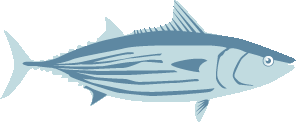Overview
What is a Completed FIP?
Completed FIPs are those that have independent verification that they have achieved their environmental objectives and/or graduated to MSC full assessment or other program assessment. Completed FIPs no longer report on their environmental performance but may choose to voluntarily report on their social performance.
Date of Completion: May 2022
Explanation of Completion: Part of the FIP's scope has moved into full assessment and was certified in 2022(see Completion link). The FIP vessels are also covered under the UoC for the following MSC certification which encompasses the full scope of this FIP — https://fisheries.msc.org/en/fisheries/tri-marine-western-and-central-pacific-skipjack-and-yellowfin-tuna/@@assessments (see Vessel List in the Public Certification Report).
The fishing fleet consists of six industrial purse seine fishing vessels operating in the Central Western Pacific Ocean varying in length from around 50m to 90m that are all company (CFC) owned. These vessels target Skipjack and yellowfin tuna. The RFMO is the Western Central Pacific Fisheries Commission (WCPFC). Parties to the Nauru Agreement (PNA) is a sub-regional agreement on terms and conditions for tuna purse seine fishing licenses in the region. The PNA provides the basis to establish a limit on vessel days known as the VDS. The allocation is zonal with days allocated to each country in the Arrangement. The CFC fleet fish both in the EEZs (exclusive economic zones) of coastal states as well as the high seas. Some of the coastal states include Papua New Guinea, Kiribati, Federated States of Micronesia, Marshall Islands, Nauru, Palau, Solomon Islands, Tuvalu and Tokelau. The catches in each country vary significantly between years for any specific month depending on the migration patterns of the tuna. The majority of the fishing occurs by setting the purse seine around schools aggregating near naturally drifting or purpose-built Fish Aggregating Devices know as FADs. Although the CFC boats catch tuna from both free and associated schools during fishing trips, the majority of vessels use FADs. Searching for the FADs and fish schools and assessing their size and direction of movement is an important part of their fishing operation. The tuna are generally sold and transhipped onto carrier vessels for processing in Bangkok, in ports such as Pohnpei, FSM.
The fishing fleet consists of six industrial purse seine fishing vessels operating in the Central Western Pacific Ocean varying in length from around 50m to 90m that are all company (CFC) owned.
The scope of the FIP will focus on:
- supporting the data collection & reporting on FADs to help determine FAD limits and improve stock assessments;
- use of non-entangling & biodegradable FADs and implementation of bycatch mitigation and handling best practices
In 2020 CFC will begin to provide FAD operational data beyond the WCPFC minimum requirements as it responds to the WCPFC science body-specific requests. This will continue throughout the duration of the FIP. This will include monitoring and the collection of any sources of potential unobserved mortality for underwater FAD structures. For all ETP species, the fishery will collect and report interactions and fate of any releases as well as the use of mitigation and handling techniques.
- CFC will replace all entangling FADs with non-entangling FADs across its fleet by the end of 2020.
- CFC will develop a suite of bycatch mitigation and handling best practice guidelines by the end of 2020 and implement these measures across its fleet by the end of 2021.
- CFC will begin to trial alternative biodegradable materials for its FAD design and construction from 2020 through 2022. The preferred material and design will begin to be implemented across its fleet in 2023 through 2024.
FIP at a Glance
| 4% | 25% | 71% |
This pie chart represents completed environmental actions. Non-completed environmental actions may contain completed sub-tasks that are not illustrated here. For more information on environmental action progress visit the Actions Progress tab.
- Complete
- Incomplete


